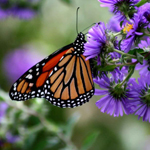 Gardening for butterflies is a suspenseful art, a bit like holding a picnic and wondering if your invited guests will show up. It’s because butterflies are choosy insects. Any gardener can have aphids, but red admirals, painted ladies and tiger swallowtails insist upon certain amenities, such as sunshine and shelter from wind.
Gardening for butterflies is a suspenseful art, a bit like holding a picnic and wondering if your invited guests will show up. It’s because butterflies are choosy insects. Any gardener can have aphids, but red admirals, painted ladies and tiger swallowtails insist upon certain amenities, such as sunshine and shelter from wind.
Content Counts, Not Style
To butterflies, the plants in a garden are more important than the design. They need flowers for nectar throughout the growing season. Luckily, many common annuals and perennials are top-notch nectar flowers. While native American species play an important role as host plants for hungry butterfly caterpillars, most adult butterflies have cosmopolitan tastes, supping as readily on the nectar-filled flowers of exotic plants as natives.
Butterflies seem especially attracted to gardens boasting generous patches of a given nectar flower. If you plant Jupiter’s-beard (Centranthus ruber), don’t settle for one or two plants. Try growing three or more patches of this especially popular nectar flower, and watch the swallowtails drift from clump to clump.
What’s in My Garden
Because I love old-fashioned cottage gardens, my garden is filled with informal groups of plants of varied heights, including many low growers spilling forth onto the garden’s gravel paths.
Grape hyacinths, Pulmonaria, rock cress, azaleas, lilacs, wallflowers and pinks furnish nectar in early and mid-spring. From late spring on through autumn, many butterfly plants bloom. Primula vialii, the June-blooming orchid primrose, is thickly interplanted with tall forget-me-nots. I use perennial alpine pinks, biennial sweet William, and self-sowing annual candytuft to edge beds of Jupiter’s-beard and June-blooming yarrows (Achillea) such as pale yellow ‘Taygetea’ and ‘Moonshine’. I planted tall perennial phlox and purple coneflowers behind the Jupiter’s-beard to provide color and nectar in July and August.
Joe-pye weed (Eupatorium purpureum) dominates one end of the garden. It waves its butterfly-laden flower heads for weeks in late summer. In front of it are patches of red bee balm (Monarda) and the tall hybrid yarrow, ‘Coronation Gold’. A large drift of purple-flowered anise hyssop (Agastache foeniculum), completes the picture. Although the garden hosts a variety of nectar flowers, the butterflies concentrate when anise hyssop and Joe-pye weed bloom. Edging this bed are clumps of golden marjoram, oregano, rosy-flowered ice plant (Hylotelephium spectabile ‘Carmen’), and the little Mexican daisy (Erigeron karvinskianus).
In September and October, purple hardy asters, backed with golden sneezeweed (Helenium autumnale) and ‘Taiyo’ sunflowers, create a dazzling picture.
In arid regions use drought-tolerant butterfly flowers. Asters (Aster novi-belgii), butterfly weed (Asclepias tuberosa), Coreopsis, fleabane (Erigeron), Jupiter’s-beard, Lantana, lavender, Sedum, verbena, and yarrow all thrive on dry, sunny sites.
